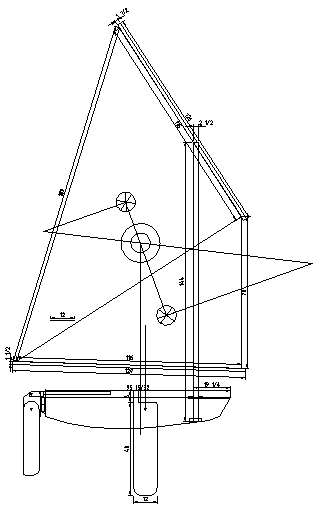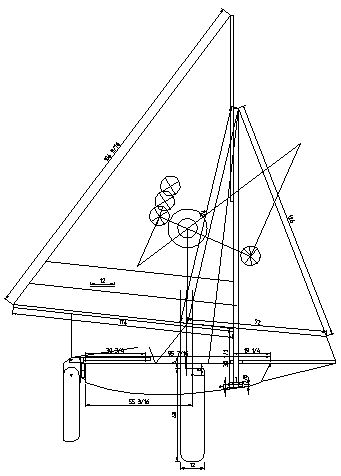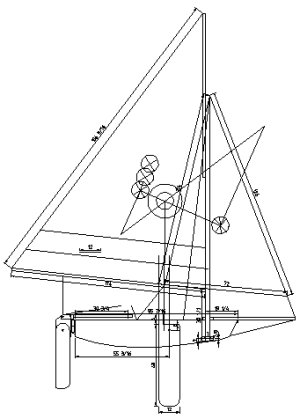Like most small boat builders I spent a fair amount of time agonizing over which boat I would build. In fact, I came very close to building a Rebel Cat, and I still think that a multihull would be pretty fun to build. In the end I decided on a Puddle Duck Racer, mostly because I thought that the boat would be dead simple to build. However, I also work with Free Software and there is no question that the fact that Puddle Duck Racer plans have to be made available for free also appealed to me. I like the idea of a community of sail boat builders collaborating on design. The fact that these designs (at least potentially) compete against each other in actual races sounds like a huge added bonus.
Of course, the PDR was so easy to build that I almost couldn’t help but design one myself. I personally think that Nephi’s Courage turned out pretty slick, but there has definitely been a learning curve. In fact, I had to learn how to use CAD software before I could even get started. If you are more interested in just building a PDR then you might want to consider one of the following pre-made designs.
You also might want to take a look at Mik Storer’s Oz Racer, or John Welsford’s Kiwi Duck. Both of these boats can be built so that the conform to the Puddle Duck Racer rules. I can understand why these designers have changed their plans so that the boats are no longer technically pdracers, but I think that this schism is unfortunate. It would have been just as clean for them to offer basic pdracer plans and then sell a book with detailed instructions. This is essentially what Jim Michalak and Gavin Atkins do. By the way, if you are considering building a boat of your own, you should absolutely buy Michalak’s and Atkins’ books. Both of these books are well worth the small investment of money and time. There are several things that I would have done differently if I had read these books first.
There are an awful lot of decisions to be made if you are building a Puddle Duck, especially if you are designing your own. I wanted side air boxes, spars that were 12 feet or less (so that they would fit on my mini van), and a whole lot of sail area for the fluky winds that I would be sailing in. Originally that equated to a balanced lug sail, and I drew up an entire set of plans with that rig.

However, I decided to change the rig on my Puddle Duck after taking my son sailing in San Diego. We rented a 14 foot sloop, and he enjoyed working the jib so much that I decided to fit Nephi’s Courage with a jib as well. This does complicate things for those times that I sail single-handed, but so far that has a been a very rare occasion. I basically always sail with crew. In fact, the last few times I have gone sailing I have had so much crew that I towed a mouse boat behind.
As you can probably imagine, that decision really shook up my design. I really like the gunter rig that I came up with, but there is no question that the gunter rig required a lot more work than a balanced lug. While it is technically true that my gunter rig and a balanced lug require the same amount of spars, the gunter rig has more complicated spars, and required considerably more expensive fittings. The gunter jaws were tricky enough (at least with my square spars) that my original design actually failed, and I had to redesign them. The gooseneck on the boom is nice, and it wasn’t too difficult to install, but it was also the single most expensive piece of equipment that I purchased for the boat (about $28 at Duckworksbbs.com). If you count the bowsprit as a spar (and I do), then the gunter rig even required an extra spar.
Adding a jib also meant that I added rudimentary standing rigging. I’ve got a forestay that the jib is attached to, and shrouds. There is also a bobstay pulling the bowsprit down. I got a very good deal on the Dyneema cord that I use for this rigging, and most of the fittings for the rigging were pre-made bits from the hardware store. The roller furling rig is made out of PVC, and the extra sail came out of the same tarp that I cut my mainsail out of. Still, the added costs for this rig add up to nearly $75, and that’s a lot considering the entire boat cost just barely more than $300. Not to mention the fact that all of this rigging has to be set up each time I go sailing. That is perhaps the biggest downside of this particular rig. There is no question in my mind that I could go sailing more often if it took less time to set up the sailboat.
That being the case the gunter rig and a roller furling jib give you lots of options when it comes to tweaking for performance or balance. I built the pdracer so that I could teach my children how to sail, and the rig gives plenty of options for delegation without being too much for a single handed sailor. In theory it should perform well too, but I am afraid I might have made my hull too heavy to really be competitive. One thing is certain, it points well, and it is easy to raise and strike the sails while on the water, even with a fair bit of wind. This makes switching between rowing and sailing very practical. This ability to drop the sail quickly and row actually made it possible for me to navigate the narrow harbor at Lincoln Beach on our last trip. Sailing in the narrow channel, especially with the wind dead on the nose, would have been very difficult.
I plan to write a separate article about the rigging, so I’ll stop there.
Originally, I designed the new gunter rig so that it would use the same mast step and partner locations and the same leeboard position as the balanced lug. That way if the rig that I designed was horrible I could simply steal the balanced lug rig that I had “borrowed” from someone else. In fact, that’s basically how I came up with the dimensions for the jib and mainsail. The leeboard position wasn’t exactly the same, but it was close.

The reality, however, is that if I am more likely to build a completely new hull than I am to test a new rig on the existing hull. The gunter rig works well enough that I doubt that a lug rig would outperform it. On the other hand 3/8 inch pine plywood I used for the bottom makes for a very sturdy boat, but it is also very heavy. That’s almost certainly the right trade off with the crew of pirates that I normally sail with. My girls get a kick out of turning the boat over and practicing their clogging on the upside down hull. You can’t do that with thinner plywood. It doesn’t put Nephi’s Courage at a significant disadvantage when it comes to racing though.
This article has been boring enough that I don’t think my wife will read this far down. So it is probably safe to say that I think that it is pretty likely that I will someday soon build a racing hull. In that case being able to swap out both sets of rigging would be pretty cool.
Well, this article has been more than long enough. Hopefully the next article will be a sailing report. If not, I still want to write about the details of how the boat is rigged, and how the spars were constructed. It probably also would be interesting to offer up my take on sail construction. I can’t sew hardly at all, and yet my sails still seem to work. Part of that is almost certainly due to my neighbor Karl, who did the bulk of the original work on my sails. However, a fair portion of the success of the sails is due to the fact that you don’t have to be very good at sewing to make sails. I sailed for nearly an entire season before I put in a single stitch of thread. Tape alone held up for quite a while.
